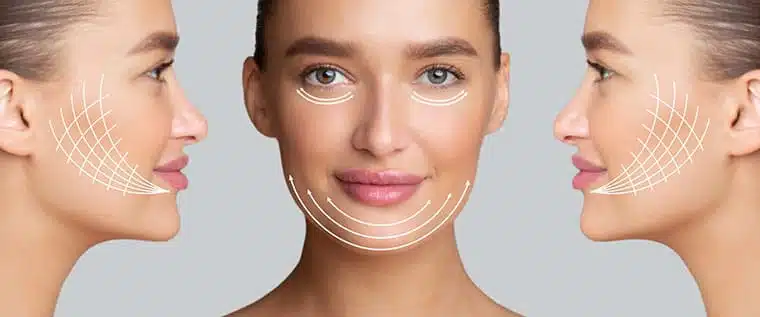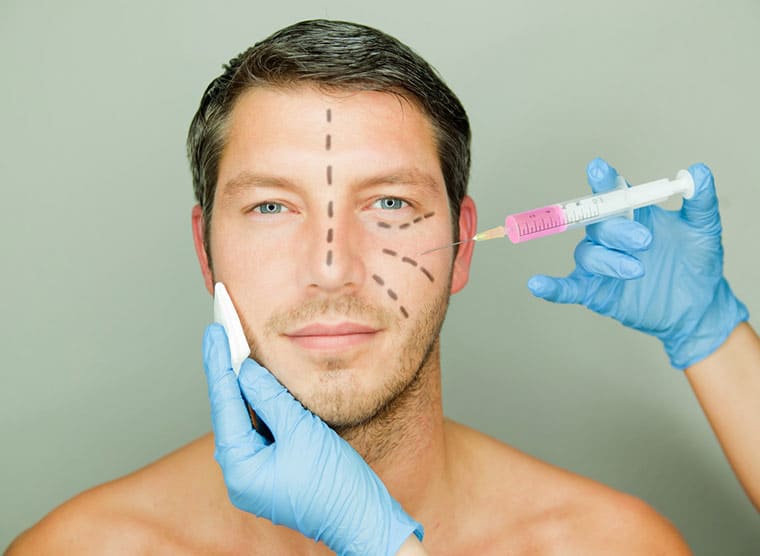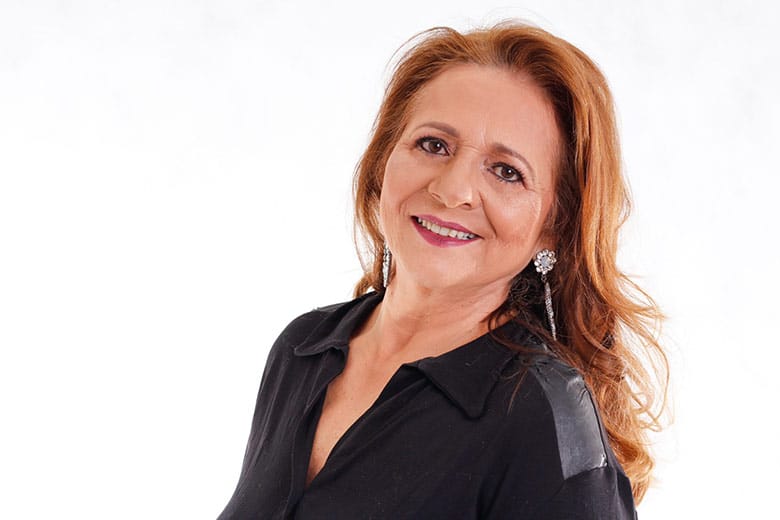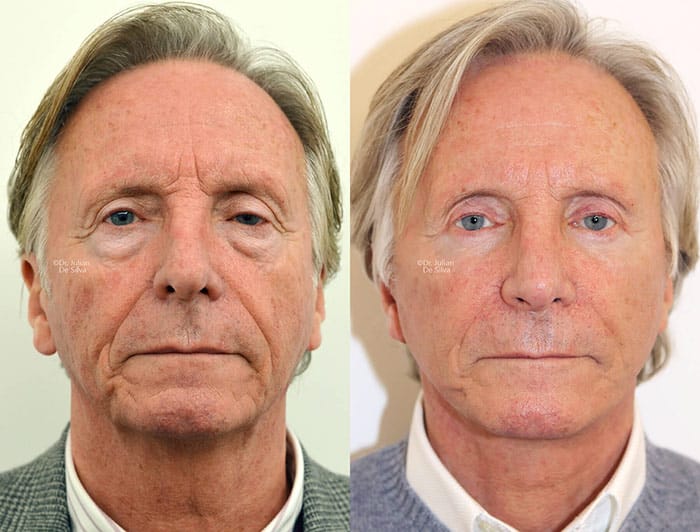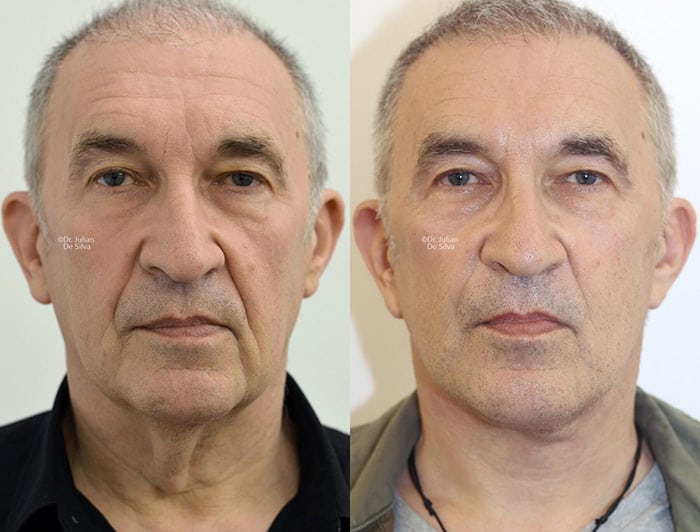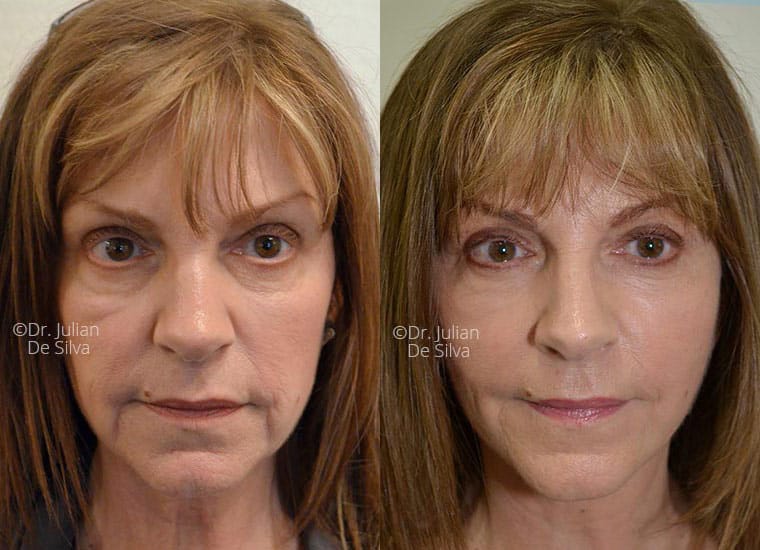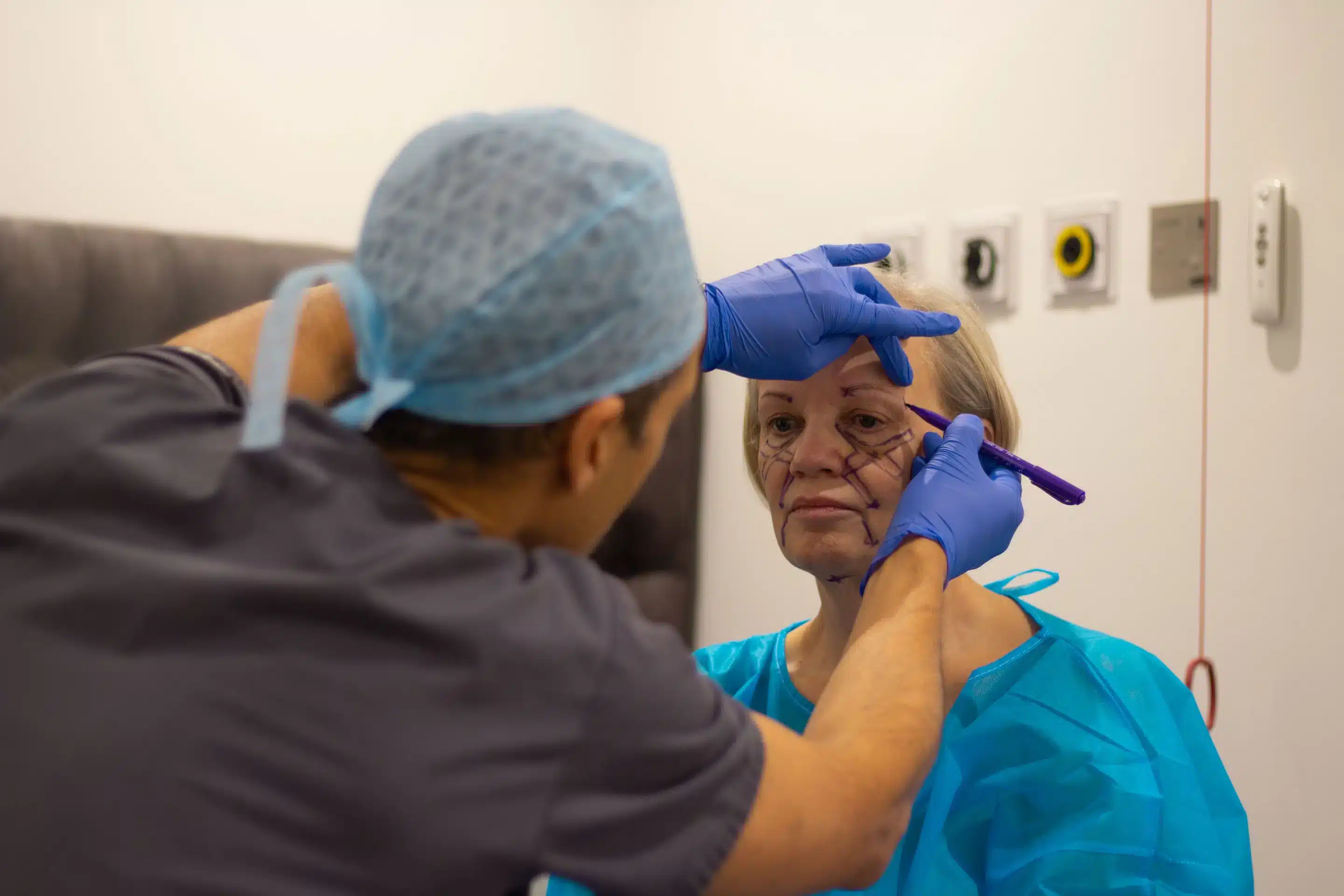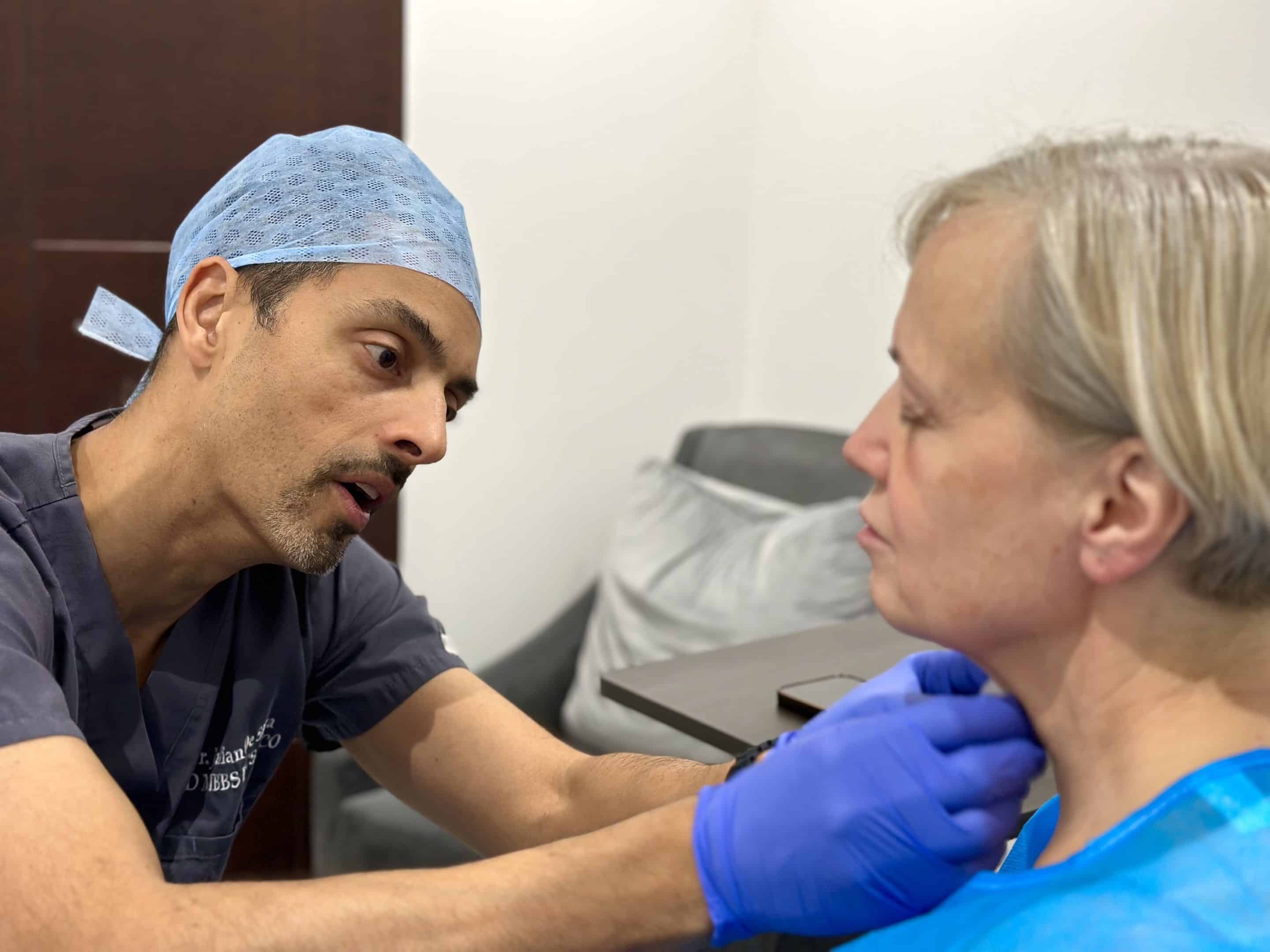A deep plane facelift brings natural, long-term benefits.
From giving you a youthful look to increasing your confidence, a deep plane facelift can do wonders.
But what exactly is a deep plane facelift? How does it differ from other types of facelift? Is it better than standard facelift surgery?
In this article, I’ll answer all of the most common questions about deep plane facelift.
What Is a Deep Plane Facelift?
A deep plane facelift produces long-lasting, more natural, and more subtle results.
The deep plane describes the place that exists between the SMAS-platysma complex and the deep layer of muscles used for facial expression.
In case you’re wondering, the SMAS-platysma complex is composed of muscles and the fascia― the band of connective tissues beneath the skin. The fascia attaches, encloses, and stabilizes the muscles.
As its name implies, a deep plane facelift focuses on the face’s deep plane. The original concept was to operate beneath the supportive layer of the face, as opposed to just operating on the skin.
This method worked because facelift surgeons found out that when skin is pulled up, it ends up being tight. Since the skin is naturally elastic, operating on it produced results that didn’t last as long. Plus, the results can look unnatural with stretched lines in people with thinner skin.
Hence, operating on the deep plane can produce long-lasting, more natural, and more subtle results.
However, as promising as its results are, the deep plane facelift is the most advanced type of facelift. Due to its nature, less than 5% of plastic surgeons can do it.
I am proud to be part of this small percentage. I personally developed a signature deep plane facelift based on my extensive experience and research in facial anatomy & surgery.
My signature deep plane facelift incorporates the principles of a deep plane facelift and the Golden Ratio. It also involves special techniques to minimise pain.
In particular, the deep plane facelift leaves the skin attached to muscle layers, lifting only under the said muscle layers.
The procedure also lifts the cheeks by releasing the attached points of the face. This eliminates the need for additional filler or fat.
By doing these, my signature deep plane facelift produces more natural results compared to other surgical facelift types.
At the end of every procedure, my patients achieve sharper, subtle, and more natural looks.
My signature deep plane facelift is best for people aged 40 to 60. Ideal candidates are those suffering from significant fine lines, wrinkles, facial volume loss, sagging skin, and jowls. Recovery time can take up to two weeks.
Deep Plane Facelift vs. Other Types of Facelift
Comparing deep plane facelift surgery with other types helps determine the best procedure for you.
The best facelift type varies from one person to another. Hence, it helps knowing the differences between my signature deep plane facelift and other types of facelift.
Deep Plane Facelift vs. Skin-Only Facelift
Surgeons used to do facelift procedures by operating on the skin only, making the skin-only facelift one of the most traditional types of facelift.
As its name implies, the skin-only facelift involves operating on the skin. It does not lift the tissue beneath it. On the other hand, the deep plane facelift involves operating under the supportive layer of the face.
The skin-only facelift produces instant results. Recovery time (1 to 2 weeks) is shorter than that of a deep plane facelift. However, the results of my signature deep plane facelift last longer than those of a skin-only facelift.
Deep Plane Facelift vs. SMAS Facelift
SMAS stands for superficial muscular aponeurotic system. Hence, the SMAS facelift targets the said area.
Just like the deep plane facelift, the SMAS facelift also targets the lower two-thirds of the face.
However, the primary difference is the SMAS facelift raises the skin and SMAS layer separately. The deep plane facelift raises them together.
Recovering from an SMAS facelift UK takes longer than recovering from a deep plane facelift. In particular, it takes 3 to 8 weeks. The results of my signature deep plane facelift also last longer than those of an SMAS facelift.
Deep Plane Facelift vs. MACS Facelift
MACS stands for minimal access cranial suspension. A MACS facelift targets the underlying muscles of the face.
The deep plane facelift targets a larger area compared to a MACS facelift. Recovery time (3 to 4 weeks) is slightly longer compared to my signature deep plane facelift. The results of my signature deep plane facelift last longer as well.
Deep Plane Facelift vs. Mini Facelift
A mini facelift is done by making tiny incisions on the face. Since the incisions are small, a mini facelift produces less dramatic results compared to my signature deep plane facelift.
In addition, a mini facelift only involves the skin. On the contrary, the deep plane facelift involves the skin and supportive layer of the face.
You can recover from a mini facelift (1 to 3 weeks) faster than a deep plane facelift. However, the results of my signature deep plane facelift last longer.
Deep Plane Facelift vs. S-Lift
The S-lift involves S-shaped incisions and removing excess skin and fat.
Recovering from an S-lift (3 to 5 days) is shorter than recovering from a deep plane facelift. However, the results of my signature deep plane facelift last longer.
Deep Plane Facelift vs. Standard Facelift Surgeries
Here’s a table summarizing the main differences between deep plane facelift and other kinds of face lift plastic surgery.
| Recovery Time | Best Age | Risks | |
| Deep Plane Facelift | 2 to 3 weeks | 40’s to 60’s | Bruising, swelling, & bleeding |
| Skin-Only Facelift | 1 to 2 weeks | 30 to 40 | Unnatural lines in skin Bruising, swelling, & bleeding |
| SMAS Facelift | 3 to 8 weeks | 40’s to 60’s | Bruising, swelling, bleeding, & delayed wound healing |
| MACS Facelift | 3 to 4 weeks | Late 30’s to 60’s | Bruising, swelling, scarring, & bleeding |
| Mini Facelift | 1 to 3 weeks | Late 30’s to 40’s | Bruising, swelling, bleeding, & scarring |
| S-Lift | 3 to 5 days | Late 30’s to 60’s | Bruising, swelling, & bleeding |
Deep Plane Facelift Recovery
Recovering from a deep plane facelift often involves bruising and swelling around the affected area for the first few days. However, they eventually disappear on their own.
Since my signature deep plane facelift is done on the supportive layer of the face, you’ll experience minimal bruising, swelling, and pain after the procedure.
In addition, my signature deep plane facelift doesn’t sever the blood vessels between the muscle and skin. Hence, you can heal quickly.
Facelift involving the SMAS can disrupt the blood vessels, and so bruising and swelling are greater in non-deep plane facelifts.
You might also be prescribed some pain medication to help you feel more comfortable during recovery. Applying cold compress, elevating your head while sleeping, and getting plenty of rest can also help you recover faster.
Deep Plane Facelift Scars
My signature deep plane facelift produces minimal to zero scarring. Since the deep plane facelift does not separate the skin from the muscles, there is no tension on the incision lines when closed. This makes the incisions less noticeable.
In addition, a deep plane facelift prevents pulling the earlobe, which can create a pixie ear. A pixie ear is a deformity in which the earlobes become elongated and pulled down after a face lift plastic surgery.
Deep Plane Facelift Benefits
From producing natural results to boosting your confidence, a deep plane facelift has many benefits.
A deep plane facelift has many benefits. As one of the few surgeons who can do a deep plane facelift, I have developed special techniques you can benefit from.
Here are the benefits of a deep plane facelift.
1. A deep plane facelift produces natural and subtle results.
My signature deep plane facelift produces more natural and subtle results compared to other types of facelift. It’s because of the precise customised surgical techniques I use. These techniques are based on extensive research and experience.
In addition, a deep plane facelift does not just pull back the skin. Due to this, its results last longer compared to other types of facelift procedures. It can last up to a lifetime, without the need for additional fillers or fat.
2. A deep plane facelift reduces various signs of ageing.
Our skin becomes less elastic as we age. Due to this, common signs of ageing become more noticeable. Our wrinkles become deeper. Our skin sags more.
A deep plane facelift effectively reduces signs of ageing such as sagging skin, jowls, nasolabial folds (lines from the edge of the nose to the mouth), and excess neck fat. After a deep plane facelift, you can expect smoother, younger-looking skin.
3. A deep plane facelift acts as prevention.
If your profession (e.g. acting, modeling) relies on your appearance, a deep plane facelift can help you fight signs of ageing early.
In addition, getting a facelift early helps you recover faster. It’s because there’s less tissue repositioning done.
4. A deep plane facelift boosts your confidence.
Aging is a natural process. However, many people are worried about looking old and tired all the time.
This is where a deep plane facelift comes in. It gets rid of any worry you have about your looks. As a result, you become more confident and ready to take on the world.
5. A deep plane facelift is a permanent solution.
A deep plane facelift offers a more permanent solution compared to non-invasive facelift treatments. It can last up to a lifetime, without the need for fillers or non-surgical procedures.
In addition, a deep plane facelift saves you a lot of money in the long run. It’s because you don’t have to keep on getting treatments over decades.
Deep Plane Facelift FAQS
A deep plane facelift’s results last longer and look more natural than those of standard facelift surgery.
Is a Deep Plane Facelift Better Than Standard Facelift Surgery?
In general, yes. A deep plane facelift is better than standard facelift surgery. For instance, if you’re wondering which is better―an SMAS or deep plane facelift ― surgeons will say it’s the latter.
It’s mainly because a deep plane facelift’s results last longer, look more natural, and appear more subtle than those of standard facelift surgery.
However, the best facelift varies from one person to another. A deep plane facelift may be the best for you, but not for another patient.
The best facelift depends on your age, genetics, skin condition, goals, and lifestyle. Consulting a doctor is a must to know the best facelift for you.
Am I an Ideal Candidate for a Deep Plane Facelift?
Deep plane facelift works best for patients aged 40 to 60. It is ideal for those who have significant signs of ageing such as fine lines, wrinkles, sagging skin, facial volume loss, and jowls.
Candidates must also be in good health. During your consultation with me, we will discuss your medical history to see any possible complications. I will also determine if my signature deep plane facelift is the right procedure for you.
How Long Does a Deep Plane Facelift Take?
It mainly depends on the amount of tissue and skin to be dealt with.
To give you an idea, a deep plane facelift surgery can take 2 to 4 hours. The procedure can take longer if there are other treatments needed aside from the facelift.
I take as much time as needed to ensure the best results.
How Much Does a Deep Plane Facelift Cost?
Each patient has unique needs and goals. Some need more adjustments, while others need fewer.
A deep plane facelift UK can cost £14,000 to £30,000.
It can increase depending on the additional treatments needed such as volume enhancement (fat transfer) and chin augmentation.
Please take note that a facelift is a complex procedure that requires many years of medical training and experience. Hence, it costs high.
However, a deep plane facelift is a one-time investment that lasts a lifetime.
What Happens After a Deep Plane Facelift Surgery?
A bandage is placed around your head. This supports your face and reduces swelling. We also use micro-drain for some patients to enhance recovery.
My patients can leave the clinic after 1 to 2 hours. Most patients experience little to no pain. However, strenuous activities like exercise must be avoided.
I also see my patients the day after the surgery to provide my contact details. I do this so anyone can contact me anytime.
In 5 to 7 days, your facial stitches will be removed. After 2 weeks, most of the swelling will be gone.
Deep Plane Facelift Before and After
Here’s a facelift recovery photo journal of my patients.
Patient Before and After 1: This patient suffered from deep nasolabial folds (smile lines), wrinkles, jowls, and significant sagging skin. Before coming to my clinic, his jaw and neck were uneven. His eyes look tired and uneven as well.
The patient had a facelift and necklift. The procedure included customised techniques that hid the scars in the natural curves around his ear, within the hair, and behind the ear.
After the surgery, the patient had a smoother jawline, an even neck, less nasolabial folds, eye bags, & wrinkling, and a younger-looking face. His eyes became more alive as well.
Patient Before and After 2: This patient suffered from significant sagging skin, wrinkles, deep nasolabial folds, and a turkey neck. Before coming to my clinic, her jaw was uneven, her skin sagged all over her face & neck, and her eyes looked tired.
The patient had a facelift and necklift with fat transfer. Micro-cannula neck fat reshaping and reduction to restore a more youthful jaw and neck angle was also done. The procedure included customised techniques that produced natural results, just like what the patient wanted.
After the surgery, the patient had a smoother jawline, an even neck, less wrinkling, better skin, and a younger-looking face.
Patient Before and After 3: This patient suffered from wrinkles, sagging skin, deep jowls, and deep nasolabial folds (smile lines). Before coming to my clinic, he had a tired and uneven look with a turkey neck.
The patient had a facelift and necklift. The procedure included customised techniques that hid his scars in the natural curves around his ear, within the hair, and behind the ear.
After the surgery, the patient had a smoother jawline, an even neck, less noticeable nasolabial folds, and a younger-looking face.
Patient Before and After 4: This patient suffered from wrinkles, sagging skin, noticeable jowls, and deep nasolabial folds (smile lines). Before coming to my clinic, she had a tired look with an uneven chin.
The patient had a facelift and necklift with fat transfer and laser resurfacing. The procedure included customised techniques that rejuvenated her face and eliminated her problems.
After the surgery, the patient had a smoother jawline, an even neck, a younger-looking face, and less visible jowls, wrinkles & nasolabial folds. Her skin became smoother as well.
Patient Before and After 5: This patient suffered from sagging skin, especially around her face and neckline. Before coming to my clinic, her jaw was uneven. Her small chin exaggerated this appearance.
The patient had a facelift and necklift. The procedure included a triple-layered closure of the skin to avoid scarring and ensure long-term results.
After the surgery, the patient had a smoother jawline, sharp neck-jawline angle, and younger-looking face.
What is a Deep Plane Facelift?
Do you feel like your face is ageing too fast? Are you losing your confidence because of it? Then it’s time to get a facelift procedure. In this article, I’ll discuss commonly asked questions regarding deep plane facelift.
Thanks to advanced technology, you can choose from many types of facelifts.
From giving you a youthful look to increasing your confidence, a deep plane facelift can do wonders.
But what exactly is a deep plane facelift? How does it differ from other types of facelifts? Is it better than standard facelift surgery?
In this section, I’ll answer all of the most common questions about deep plane facelift.
What Is a Deep Plane Facelift?
How does it differ from other Types of Facelift
Deep Plane Facelift Recovery & Scars
Deep Plane Facelift Cost
Signature Deep Plane Facelift
Deep Plane Facelift Before and After & Case Studies
Speaker
Dr. Julian De Silva
Transcript
Hello, welcome to my frequently asked questions. Today I’m answering questions about deep plane facelift. What are the frequently asked questions regarding this procedure?
Well, in essence, there’s seven main questions that patients ask me, what is the deep plane facelift? Is it better than another type of facelift? Is Am I a good candidate for this kind of procedure? How long does it take? What is the recovery? What is the cost? And ultimately, what are the potential issues? Am I going to have pain? So, we’re going to go talk through each one of these in turn.
I’m a facial cosmetic and plastic surgeon based in London, I specialise only in the face and face lifting and deeply face lifting is something I do every day in my practice, about 20 to 30% of all the patients are treated our revision patients who come from elsewhere. And previously I’ve worked in the cosmetic capitals of Los Angeles and New York before my practice in London. So in terms of this information that I’m talking to you about today, well, no information in this form can constitute medical consultation.
And really, each kind of procedure, particularly face of surgery needs to be taken in an individual basis and customised to each person individually. So, what is a deeply facelift? Well, first of all, we need to look at kind of what is facial ageing, and how can facial ageing, be remedied or rejuvenate. So if we start by looking at a case study, well, this is a patient who presented to me with my significant jowls, and by that it means soft tissues calm down with gravity, creating this fullness along the jaw line.
And in a way, there’s also sagging of the skin, loose skin, there’s a loss of the nice sharp angle in the neck. And sometimes this is rather unflatteringly described as a turkey neck. And there’s also like loose skin in the neck area and around the jawline. And ideally, we want like a procedure that’s going to be natural, it’s going to rejuvenate the face to where it began. And that means lifting things in the direction in which they dropped against gravity. Let’s have another look at a different patient. Well, this patient has very deep nasal Abo grooves and these lines that go from the nose down was towards the jawline.
In addition to that, there’s also like soft tissue on the jaw line and loss of that natural, smooth and even jaw line. And the fullness in the neck, which is partly loose skin. It’s partly the soft tissues beneath the skin, and then just a slightly kind of tired appearance. So is deep plane facelift better than a standard facelift? Well, what deep plane facelift surgery means is lifting the deepest soft tissues to where they began. So it’s very much even vertical lifting direction. The short answer to this, in my opinion is yes, it is a more natural facelift and that it’s lifting things back to where they started. It recreates the youthful V-shaped jaw line now with ageing your jaw line become square as areas drop down with gravity, and lifting things back to where they started, which is what deep plane facelifting does recreates that V shaped jawline.
So if we look at this image, well, the case studies that we’ve looked at, we’ve seen how the volume of the cheek is dropped down creating this fullness in the jowl area, fullness in the neck, so deeply in face of lift this back up and restores the anatomy to where it used to be. And by doing that it’s natural, it improves and softens those lines that we looked at, recreate some more Vshape jaw line and beautifies effects. Now it does differ from the standard face that were that tends to be lifting more towards the air, which does make a difference but it doesn’t restore the natural volume to where it used to be.
The technique is more challenging, and only a small proportion of surgeons truly conduct deeply in facelifting. It does take more time and sometimes it requires additional procedures in order to get the best results because if you have a lot of loose skin and everything is lifted up, well that loose skin may mean that you need to do something around the brow area like lifting the brow just to take away some of that loose skin to give the best result. So secondly, am I am I am I an ideal candidate for deep plane facelift? Well, ideally for this kind of procedure you do need significant facial ageing.
Now, if you only have mild changes, a mini facelift technique or technique focusing on addressing the more laxity and skin while those techniques are going to be preferred, but if you have significant facial ageing, and that’s going to be towards the age from 40 to 60 onwards, and that means like sagging skin, a drop of volume with gravity, jowls, and of course, you’re in good health. And yes, there will be some recovery in terms of swelling. And it’s important to be realistic about the expectations from that. Other things were in terms of smoking, well, that’s a complete no for January, this kind of surgery because you’re going to heal slower. And there’s more potential issues with healing of the skin and the scars.
So things like good health and absence of smoking for at least a period is definitely going to help you. How long does this procedure take? Well, any procedure needs to be balanced about in terms of what is required and what the recovery will be. So generally a deep plane facelift? Well, it’s a procedure that’s going to take three to five hours. And it’s really difficult to have a procedure that’s going to be less than that, because what is required during the procedure. And often, well, there are going to be other factors that need to be taken into consideration. A common thing might be well, you might have lost some volume. And rather than using fillers, where we can use your own fat in terms of fat transfer, and that will restore more natural volume to your face.
There could be other things such as resurfacing the skin with a laser that will polish the skin and improve the fine lines and enlarged pores. So these procedures are often used in conjunction with deep plane facelift can give the best results. What is the recovery? Well, generally advise patients that 80% of the swelling will go between two and six weeks. And generally you need a good three weeks for most recovery and most fun to cut. Now, some patients can look really good even after one or two weeks. And that’s great. And that’s for sure for those patients. But then other patients can naturally have a bit more swelling. And that can be sometimes more towards six weeks.
And so for most people, I advise you to have three weeks in terms of recovery. But if you have something really important like an important event, an important birthday or wedding, but I would say definitely have six weeks just in case and like all things in life you have some people will heal really quickly. And some people can take a bit longer and you can have a bit more swelling. And there are things that we can do in terms of medicine, there are medications that are techniques such as lymphatic drainage, there are there are things that we can do to speed up healing, but you have to allow for swelling because swelling can be the main thing with healing.
Now there are other things like the anaesthetic Well, in my experience using sedation, that’s much milder than using general anaesthetic and that speeds up recovery reduces your chance of bruising reduces the swelling. And there are other things like that can be done after the surgery such as lymphatic drainage.
And I often work alongside specialists who are able to provide those those kind of treatments routinely for my patients. What is the cost? Well, the cost for a deep plane facelift in the UK is going to be from about 15,000 pounds.
And it’s going to vary a little bit depending on the location facility and if you needed associated techniques to get the very best results. Now, it does take quite a lot of years of training and experience to provide this procedure and it’s a longer procedure. It’s a procedure that as we talked about takes several hours, the quickest face that procedure will it can be done in an hour, an hour and a half. But it’s not going to be like a true facelift and it’s now going to reflect in the results.
And one way of looking at as an investment. My personal signature techniques will uses a variety of the things we’ve been talking about and certainly deeply in face lifting. I believe that this gives patients better results and certainly in the past I’ve offered patients from other procedures along Smith lifting and mini facelift surgery, but deeply in face lifting when combined with these procedures gives them more natural lift and beautification of effects. Quite often. I will also look to add additional procedures to get the best results. But really with this kind of procedure.
Even at 24 hours, you see an improvement in your jaw line in your neck, and more V shaped face and patients are often very happy even at this early point. Now sometimes additional procedures such as augmentation of the chin with a chin implant, and patients have a very full jawline and neck or sometimes they can require more advanced techniques such as shaving down on the deeper fat, shaving down the deepest soft tissues, which include sometimes the saliva glands that have dropped down beneath the jaw line.
Now in those patients, the cyber guns are not removed, but they reshaped in order to contour the neck and give a better result. I play principles such as the golden ratio that looks at the relative proportions of each individual’s face to give the best possible results. And often there are other techniques such as adding volume fat transfer that just make each result that little bit better and longer lasting. So in summary, well, we’ve talked about the seven frequently asked questions about deep plane facelift.
And those include what a deep plane facelift is, is it better? Who makes a good candidate? What is the recovery time? What is the cost? And ultimately, you know, what is the best result can very much depend on your individual needs? What’s the best facelift for me? Well, you certainly need to research this, you need to look for a specialist who is completing this kind of surgery every day.
With this kind of surgery 50% is kind of technical detail and the other 50% is a kind of artistry because there’s no absolute measure measure measurement in the face and neck two millimetres is going to be a perfect answer. It requires a degree of artistry to give every patient the best result. I hope that this information has been useful for you. And if you have any other follow up questions, or you’d like to see by advice in any way then please follow this link message me and sign up for my newsletter. Thank you for watching.
Knowing what are the different types of facelifts helps you understand the benefits.
Please take note that your face is unique. The best type of facelift requires a thorough assessment. You can contact us for an extensive consultation.
Also, make sure that you don’t make the biggest mistakes when choosing a surgeon.
My Experience of a Deep Plane Facelift and Neck Lift With Dr. Julian de Silva
This wonderful patient had face and neck lift surgery combined with fat transfer, including deep neck surgery (Reduction in deep fat and shaving of submandibular glands).
She shares her experience and recovery and the difference this procedure has made to her.
This is Dr. De Silva’s signature natural deep plane facelift and neck lift.
Natural enhanced neck and jawline.
I combine facelift surgery with other facial treatments to give a better natural looking and longer-lasting result.
Dr. Julian De Silva
For more information: https://londonfacialplasticsurgery.co.uk/facelift-rhytidectomy/
Dr. Julian De Silva is a London facial cosmetic and plastic surgeon, he is an expert on the latest advances in facial cosmetic surgery and does not perform any body plastic surgery.
Dr. Julian De Silva specialises in facelift & neck lift surgery, revision facelift and revision neck lift surgery, Blepharoplasty and Rhinoplasty. 20-40% of all the surgery he completes is revision surgery from other doctors.
Find out more about us: https://londonfacialplasticsurgery.co.uk/
Transcript
Well, to start with, I was terrified about having anything done (including my facelift) because I didn’t want to walk around with that stretched look that everyone seems to associate with baselitz.
So, coming here, it was very scary to begin with, until I met Dr. de Silva in which was lovely. I was still terrified, because I thought, my insecurities being I would always sit like this, all right, sit like this, and I’d hide my weak chin, I thought, you know, the wrinkles in the saggy skin as you get older.
And I thought he might not agree that I’ve got this to begin with. So it was trying to convince him of what I actually felt which, you know, he was very, very good. He listened, which was lovely. And then when I say Jess, I want to go ahead because he talked about it being natural about not having that stretch. Look, the first thing he talked about was how he works. So it doesn’t look as if you’ve had anything done, which was my biggest fear.
I didn’t want everyone to go what she had done, because sometimes it’s not a good thing for people to say think why, what’s wrong with it? Not that bad. But that’s why I went ahead. I got here this morning, which is quite early in the morning. absolutely terrified of the whole thing, but more so I thought I was gonna be awake. Because I was having the Twilight sedative. I’ve not had that before. literally walk straight in lovely atmosphere. Everyone was friendly. It was it was really nice.
And I thought okay, right now comes the scary bit walked into I thought going to be a theatre, you know, like an operating theatre, but it wasn’t. There was music playing which was lovely. Everyone was chatting, literally got on the bed, talk to the neath the test had already talked to me in the room anyway. And literally, he put the jab in the back of my arm. I literally thought I’ve had a couple of gin and tonics.
And that’s the last thing I remember. until six hours later, apparently, wow, six hours later, then six hours ago, it was over. And I literally woke up. But okay, is it done, walk back to the bedroom, and the nursing staff lovely. sat there, had a cup of coffee to the public group. And it was like I’ve not had anything done until I actually looked in the mirror at the or have had it done.
They weren’t joking, I actually had it done. So if you’re scared about the sensitivity, you’re scared about a procedure, please don’t be you don’t feel a thing. Which is a shame, because it probably would have been nice to have chatted about it. But I don’t remember a thing about it. Absolutely no pain. And I went home the next morning with absolutely no pain. I mean, they literally had to force me to take some painkillers because I didn’t feel anything. I kept waiting the whole week after risk to this pain to get there, but nothing happened. No pain. The most uncomfortable thing, which the doctor had told me about was my drains. And they’re a drain, drain, but they’re not painful.
They just get used to these things swinging around. And that was the most uncomfortable thing out of the whole procedure. But the rest, as they say is history. Right, so now where the eight, nine weeks post up and the differences, I can go out now and not have to sit down and worry about how I look. You know, I know I look okay, I know look nice.
So I’m not worried about does my chin look, you know, does my neck look terrible? In actual fact, it’s nice because I don’t have to worry about it. You know, I feel more confident. I can wear my hair up now and not have to worry about it. I’m not sitting there constantly thinking in the mirror. Is it okay, going to the bathroom. And I think all women know this, that you look in the mirror and you see the reflection back and it’s not who you think it is.
And your stomach sort of thinks you think, Oh God, I look terrible today. I haven’t had that. And that’s through all the bruising and everything. I haven’t had that feeling of not God. And that’s the fact is is lovely. Because every morning I get up and I see a different change. I see. Look at my neck, you know, and even my daughter.
My 40 year old daughter’s envious of this neck. I mean, come on, you know who wouldn’t be envious if neck? And even putting a necklace on now is you know I haven’t got that. That maglie bit. As ladies know what I’m talking about? Yeah, I haven’t got that handy bit of skin, you know, and it’s lovely. It’s like, wow. So the rest is just going to get better. And that’s lovely.
Every morning I wake up and I can see the difference. I can see a change. And in me, I can see that change in me I just feel more confident. Exactly like knowing what no What are you doing now?
Is there any advice you give to like family or friends who’s thinking about doing this? Hurry up, get it done. Don’t waste your time. Don’t waste your time worrying about it, do it because you’ll regret the time you’ve waited to do it. I regret the last sort of three or four years thinking or know what What if so, what is this? What is that? Do you research of course do your research, always do your research, feel comfortable with your surgeon and that’s the first thing I felt so comfortable with you You made me feel confident in you, which is so important.
Because this is your face you got to go through the rest of your life in your face. So do your research. You know what you want done you’re you don’t be honest with the surgeon about what you want done. And if you aren’t honest with the surgeon, he can’t do his best work because you’re not telling him what it is you’re worried about or upset about. But ultimately, you only get one life. live it to the fullest and if that means you want to do this, you do it. You don’t need to make excuses for yourself. Why should you life’s for living.
Find out more in our detailed blog post on the patient’s experience of a deep plane facelift and neck lift with Dr. Julian De Silva.
Conclusion
As seen above, a deep plane facelift can significantly change your appearance, without producing artificial results. All of my patients left deep plane facelift reviews stating how happy they are with the results.
While a deep plane facelift is better than other types of standard facelift surgeries, it might not be the best for you. To determine the best facelift for you, consult your doctor first.
Book a consultation with us now to know if a deep plane facelift is right for you!

